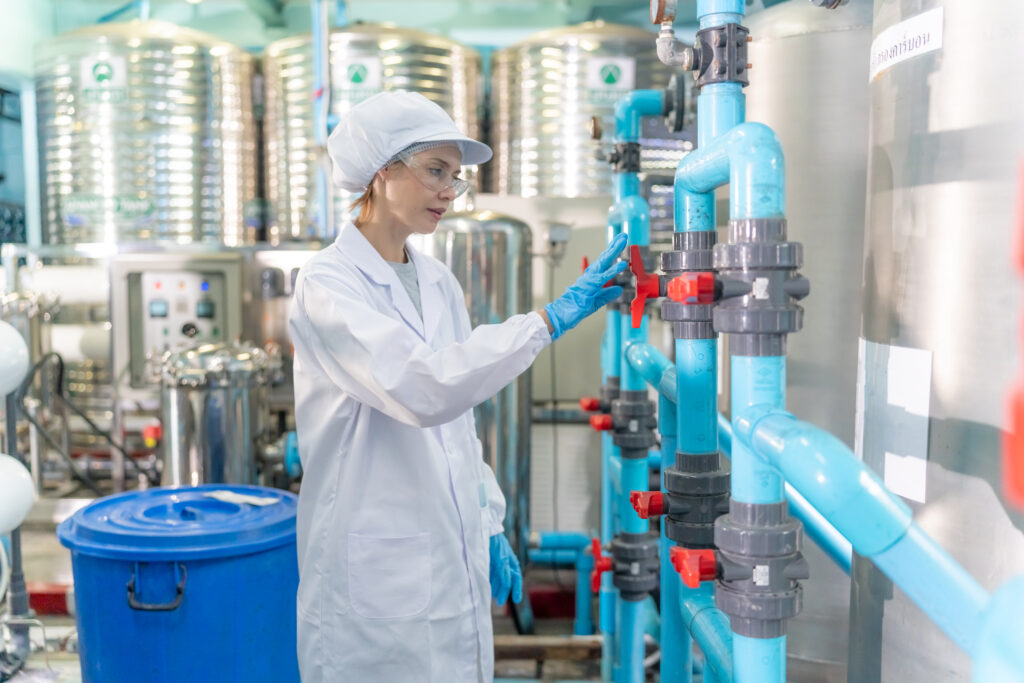Pre-Treatment
Pre-treatment of R.O Plants
Reverse Osmosis (RO) systems require effective pretreatment to ensure optimal performance, reduce fouling, scaling, and membrane damage, and extend the life of the RO membranes. Pretreatment typically involves the use of specialized RO chemicals and other processes to condition the feed water before it enters the RO system.
Key Steps in Pre-treatment with R.O Plants
Coarse Filtration
- Removes large particles like sand, silt, and debris that can clog the resin bed.
- Equipment: Sand filters or mesh strainers.
Sedimentation or Clarification
- Used to settle suspended solids in raw water.
- Helps in reducing turbidity and preventing fouling of downstream equipment.
Pre-Chlorination
- Destroys bacteria, algae, and other microorganisms.
- Important for systems drawing water from surface sources.
Dechlorination
- Removes residual chlorine that could damage the softener resin.
- Chemicals such as sodium bisulfite are commonly used.
Iron and Manganese Removal
- High levels of iron and manganese can foul resin and cause discoloration in water.
- Methods:
- Oxidation followed by filtration.
- Specialized media like greensand or manganese dioxide.
- Multimedia or Sand Filters: Further removes fine particulates.
- Activated Carbon Filters: Eliminates chlorine and organic compounds.
- Chemical Dosing: Injection of antiscalants, coagulants, and pH adjusters.
- Micron Filtration: Final step before water enters the RO system.
Antiscalants
- Prevent scaling caused by hard water ions such as calcium, magnesium, barium, and strontium.
- Disperse scaling particles and maintain smooth water flow through membranes.
- Typical dosages depend on the water chemistry and flow rate.
pH Adjusters
- Acidic or alkaline chemicals are used to adjust the feed water pH to the ideal range for RO membranes, typically 6.5–7.5.
- Common chemicals: sulfuric acid or sodium hydroxide.
Biocides
- Control microbial growth in the RO system, which can lead to biofouling.
- Some biocides are non-oxidizing, ensuring they don’t damage RO membranes.
- Regular biocide application ensures system hygiene.
Coagulants and Flocculants
- Help remove suspended solids and colloids from feed water before filtration.
- Aid in reducing turbidity and improving the efficiency of pretreatment filters.
Dechlorination Agents
- Chlorine and other oxidants can damage RO membranes. Dechlorination chemicals, such as sodium bisulfite, neutralize chlorine effectively.
- Critical for systems processing municipal water supplies.
Pre-treatment of Softener Plant
Water softener plants are designed to remove hardness-causing minerals, primarily calcium and magnesium ions, through ion exchange. Proper pretreatment ensures the efficiency and longevity of the softener resin and minimizes operational issues. Pretreatment involves conditioning the feed water to remove impurities that could interfere with the softening process or damage the equipment.
Water Pre-treatment Plant

Coarse Filtration
- Removes large particles like sand, silt, and debris that can clog the resin bed.
- Equipment: Sand filters or mesh strainers.
Sedimentation or Clarification
- Used to settle suspended solids in raw water.
- Helps in reducing turbidity and preventing fouling of downstream equipment.
Pre-Chlorination
- Destroys bacteria, algae, and other microorganisms.
- Important for systems drawing water from surface sources.
Dechlorination
- Removes residual chlorine that could damage the softener resin.
- Chemicals such as sodium bisulfite are commonly used.
Iron and Manganese Removal
- High levels of iron and manganese can foul resin and cause discoloration in water.
- Methods:
- Oxidation followed by filtration.
- Specialized media like greensand or manganese dioxide.

Process Flow for Pretreatment
- Raw Water Source → Coarse Filtration
- Sedimentation/Clarification → Multimedia Filter
- Chemical Dosing (if required) → Micron Filtration
- Softener Plant Feed Water → Ion Exchange Process
Benefits of Water Pretreatment Plants
- Protects Resin: Prevents fouling, scaling, and damage to the resin bed.
- Improves Efficiency: Reduces pressure drops and enhances ion exchange.
- Extends Equipment Life: Minimizes wear and tear on softener components.
- Optimizes Regeneration Cycles: Reduces the frequency of salt regeneration and operational costs.
Pre-treatment of Resin in Water Treatment Systems
Resin pretreatment is a critical step in ensuring the proper functioning and longevity of ion exchange systems, such as water softeners or deionization (DI) units. Resin pretreatment involves conditioning the resin before its initial use or after a prolonged downtime to optimize its ion exchange capacity and prevent operational issues.
Key Steps in Resin Pre-treatment

Initial Rinse with Clean Water
- Purpose: Removes dust, fines, and any contaminants from the resin bed.
- Process: Backwash the resin with clean, non-chlorinated water at a controlled flow rate to prevent resin loss.
Hydration of Resin
- Purpose: Ensures the resin beads are fully swollen and ready for ion exchange.
- Process: Soak the resin in water for several hours (typically 8–24 hours).
Regeneration with Suitable Chemicals
- For Cation Resins (e.g., softener resin):
- Regenerate with a brine solution (NaCl) to replace hardness ions (Ca²⁺, Mg²⁺) with sodium ions (Na⁺).
- For Anion Resins (e.g., DI systems):
- Regenerate with an appropriate chemical such as sodium hydroxide (NaOH).
- For Cation Resins (e.g., softener resin):
Removal of Impurities and Organic Fouling
- If the resin has been stored or used before, pretreatment may involve cleaning with specific chemicals:
- Acid wash (e.g., HCl or citric acid) to remove scale or iron deposits.
- Alkaline wash to remove organic fouling.
- If the resin has been stored or used before, pretreatment may involve cleaning with specific chemicals:
Dechlorination (if applicable)
- Chlorine can oxidize and degrade resin beads, especially in softening applications. Pretreatment may include neutralization of chlorine using sodium bisulfite or activated carbon filtration.
Best Practices for Resin Pretreatment
- Water Quality: Use dechlorinated or softened water for rinsing and soaking to avoid fouling during pretreatment.
- Controlled Flow Rates: Ensure proper flow rates during backwashing to prevent resin loss.
- Chemical Compatibility: Verify the compatibility of cleaning agents with the resin type to prevent damage.
- Regular Inspection: Periodically inspect resin for degradation, swelling, or fouling to determine the need for replacement.
Benefits of Proper Resin Pretreatment
- Enhances the efficiency of ion exchange processes.
- Extends the resin’s operational life.
- Prevents fouling, scaling, and operational downtime.
- Optimizes system performance and reduces maintenance costs.

